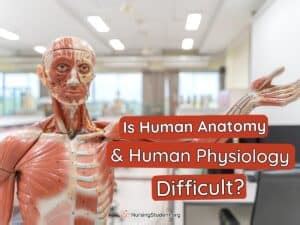Human anatomy and physiology are two of the most important and challenging subjects in the field of medicine. They provide the foundation for understanding human biology and disease, and they are essential for anyone who wants to pursue a career in the healthcare field.

Why is human anatomy and physiology hard?
There are a number of reasons why human anatomy and physiology are so difficult to learn. First, the human body is incredibly complex. It is made up of trillions of cells, and each cell has its own unique structure and function. Second, the human body is constantly changing. As we grow and develop, our bodies undergo a series of changes that can make it difficult to keep up. Third, human anatomy and physiology are often taught in a very dry and technical way. This can make it difficult to engage with the material and to understand how it applies to the real world.
How can I make human anatomy and physiology easier to learn?
There are a number of things that you can do to make human anatomy and physiology easier to learn. First, try to find a study method that works for you. Some people prefer to read the textbook, while others prefer to watch videos or listen to podcasts. Second, break down the material into smaller chunks. This will make it easier to focus on one topic at a time and to avoid feeling overwhelmed. Third, practice regularly. The more you practice, the more comfortable you will become with the material.
What are the benefits of learning human anatomy and physiology?
There are many benefits to learning human anatomy and physiology. First, it will give you a better understanding of your own body. This can help you to make healthier choices and to prevent disease. Second, it will prepare you for a career in the healthcare field. Human anatomy and physiology are essential for anyone who wants to become a doctor, nurse, or other healthcare professional. Third, it can be a fascinating and rewarding subject to learn. The human body is an amazing machine, and there is always something new to discover.
Conclusion
Human anatomy and physiology are two of the most important and challenging subjects in the field of medicine. They are essential for anyone who wants to pursue a career in the healthcare field. While they can be difficult to learn, there are a number of things that you can do to make the process easier. With hard work and dedication, you can master human anatomy and physiology and reap the many benefits that it has to offer.
Additional tips for learning human anatomy and physiology
- Use flashcards. Flashcards are a great way to memorize new information. Create flashcards for each of the major structures of the human body, and then quiz yourself regularly.
- Join a study group. Studying with a group of friends can be a great way to stay motivated and to learn from each other.
- Attend office hours. Your professors and TAs are there to help you learn. If you are struggling with the material, don’t be afraid to ask for help.
- Take advantage of online resources. There are a number of great online resources that can help you learn human anatomy and physiology. These resources include videos, podcasts, and interactive quizzes.
Tables
Table 1: The major structures of the human body
| Structure | Function |
|---|---|
| Bones | Support the body and protect the internal organs |
| Muscles | Allow the body to move |
| Nerves | Transmit signals from the brain to the body and from the body to the brain |
| Blood vessels | Carry blood throughout the body |
| Lymphatic vessels | Carry lymph throughout the body |
| Digestive system | Breaks down food and absorbs nutrients |
| Respiratory system | Takes in oxygen and expels carbon dioxide |
| Urinary system | Removes waste products from the blood |
| Reproductive system | Produces new individuals |
Table 2: The major organs of the human body
| Organ | Function |
|---|---|
| Brain | Controls the body and mind |
| Heart | Pumps blood throughout the body |
| Lungs | Take in oxygen and expel carbon dioxide |
| Stomach | Breaks down food |
| Small intestine | Absorbs nutrients |
| Large intestine | Absorbs water and electrolytes |
| Liver | Filters the blood |
| Pancreas | Produces enzymes that help to digest food |
| Kidneys | Filter the blood and remove waste products |
Table 3: The major systems of the human body
| System | Function |
|---|---|
| Skeletal system | Supports the body and protects the internal organs |
| Muscular system | Allows the body to move |
| Nervous system | Transmits signals from the brain to the body and from the body to the brain |
| Circulatory system | Carries blood throughout the body |
| Lymphatic system | Carries lymph throughout the body |
| Digestive system | Breaks down food and absorbs nutrients |
| Respiratory system | Takes in oxygen and expels carbon dioxide |
| Urinary system | Removes waste products from the blood |
| Reproductive system | Produces new individuals |
Table 4: The major hormones of the human body
| Hormone | Function |
|---|---|
| Insulin | Regulates blood sugar levels |
| Glucagon | Raises blood sugar levels |
| Adrenaline | Prepares the body for fight or flight |
| Cortisol | Regulates stress response |
| Testosterone | Promotes male characteristics |
| Estrogen | Promotes female characteristics |
